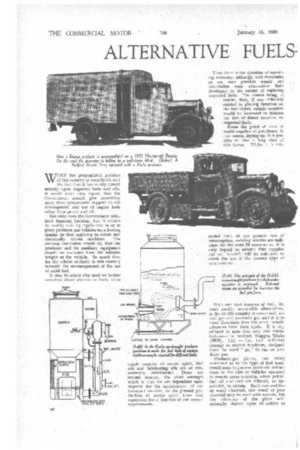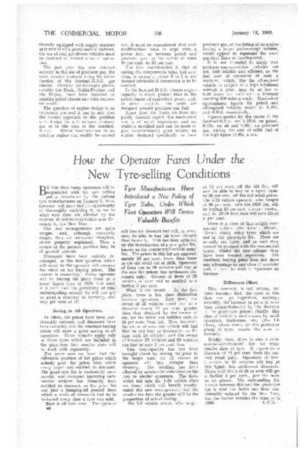ALTERNATIVE FUELS
Page 104

Page 105

Page 106

If you've noticed an error in this article please click here to report it so we can fix it.
3romising Avenues of Research Progress in 1938 is Marked by Introduction of New Gas Chassis. Possibilities of Vegetable Products as Fuel For Oil Engines WHEN the geographical position of this country is considered, and the fact that it has to rely almost entirely upon imported fuels and oils, it would seem only logical that the Government should give something more than sympathetic support to the development and use of eagine fuels other than petrol and oil.
Not only does the Government withhold financial backing, but it refuses to modify existing regulations so as to place producer-gas vehicles on a footing similar to that applying to steam and electrically driven machines. The obvious concession would be, that the producer and its auxiliary equipment should be excluded from the unladen weight of the vehicle. So much then for the official attitude in this country towards the encouragement of the use of solid fuel.
It may be asked why need we bother ourselves about alternative fuels, when ample supplies of motor spirit, fuel oils and lubricating oils are so conveniently obtainable? There are sevesal reasons, the chief amongst which is that we are dependent upon imports for the maintenance of our transport services, as the present production of motor spirit from coal represents but a fraction of our annual requirements. Then there is the question of operating economy, although' such economies as are now possible would not materialize were alternative fuels developed to the extent of replacing imported feels. The reason being, of course, that, if any difficulty existed in placing taxation on the fuel direct, vehicle taxation would be increased to balance the Teas of direct taxation on imported fuels.
From the point of view of world supplies of petroleum.. in due course; dryisime up, it is possible to take a long view of this factor. Whilst it is esti
mated that, at our present rate ot consumption, existing sources are suffiekat for the next 20 years or so, it is only logical to assume that supplies not yet located, will be sufficient to cover the era of the present type of prime-mover.
With our vast reserves of coal, the most readily acceptable alternatives, so far as this country is concerned, are coal' gas and producer gas and' it is in these directions that the most notable advances have been made. It is signific.ant to note that only one manufacturer—the Sentinel Waggon 'Works (/936), Ltd. — has had sufficient courage to market machines, designed from the word "go," to run on producer gas.
Producer-gas plants, not being restricted as to the type of fuel used, would seem to possess particular attractions in the case of vehicles operated in remote areas overseas, where petrol, fuel oil' and coal are difficult, or impossible, to obtain. Such commodities as wood charcoal, raw wood or peat charcoal may be used with success, but the efficiency of the plant will, naturally, depend upon its ability to
utilize such fuels to the greatest advantage.
That there are possibilities in the use of vegetable products, as alternative fuels, is shown by the comprehensive investigations recently made by Capt. J. Walton, of Lever Brothers and Unilever, Ltd., and which were recorded in The Commercial Motor dated September 2, l938. In vegetable products lies an inexhaustible source of supply, but owing to their lack of volatility, vegetable-oil fuels are not suitable for use in petrol engines.
Capt. .Walton' s investigations covered an extremely wide range of oil-bearing products, including castor seed, grape seed, maize, cameline, pumpkin seed, beech nut, rape, olive, soya bean, cotton seed and shea butter. The following animal substances were also tried out :—Horse fat, beef tallow, mutton tallow, hog lard, butter, seal oil, whale oil, cod liver oil, fish oil and waste lubricating oil.
Of the foregoing, the most promising results were obtained with palm, soya bean, cotton-seed and ground-nut oils, the tests including bench trials and thousands of miles running on the roads under normal service conditions.
• Although little progress has been made with the use of hydrogen, there are definite possibilities in this direction. Large quantities of this gas are obtainable from low-pressure electrolysis plants at low cost and 'a patent for a new engine, to burn a mixture of oxygen and hydrogen, has only recently been taken out.
So far as practical application on definite lines is concerned, the use of liberally equipped with supply stations as it now is with petrol service stations, the use of coal-gas-driven vehicles must be confined to limited areas of operation, The past year has seen renewed activity in the use of producer gas, the most notable instance being the introduction of the Sentinel-H.S.G. gas chassis. Portable producer-gas plants, notably the Koela, Gohin-Poulenc and the 'Dnpuy, have been installed on existing petrol chassis and with successful results.
The question of engine design is an important one and it can be said that -the correct approach to this problem is to design the unit to burn producer gas as in the case of the Sentinel H.S.G. Whilst modifications to an existing engine can readily be carried out, it must -be remembered that such modifications have to cope with .a power loss, as between petrol and producer gas, to the extent of some 30 per cent. to 50 per cent.
The first consideration is that of raising the compression ratio, but anything in excess of about 9 to 1 is not deemed advisable if detonation is to be avoided.
In the Sentinel-H.S.G. chassis engine capacity is much greater than in the petrol engine of equivalent power, and, in other respects, the units are designed around producer-gas fuel.
Apart from the limits set from the purely thermal aspect, the mechanical ene is of equal importance and so, whilst a modified unit can he made to give extraordinarily good results, an engine designed specifically to burn producer gas, or the fitting of an engine having a larger piston-swept volume„ would appear to represent the more practical lines of development.
• It is not intended to imply that producer-gas-conversion vehicles are not both reliable and efficient, as the fuel cost of operation of such a machine, which, like the oil-engined vehicle, is subject to a high minimum mileage a year, may be as low, as 0,40 pence per mile with a 5-tonner covering 800 miles a week. Equivalent approximate figures for petrol and oil-engined vehicles would be 1.70d. and 0.83d. respectively.
Figures quoted by the maker of the Sentinel-H.S.G. are 1.167d. on petrol, 0.52d. on oil and 0.30d. on producer gas, taking the cost of solid fuel at the high figure of 40s. a ton.




















































































































































